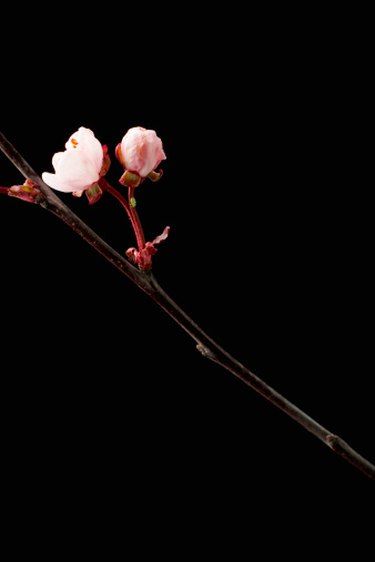
When discussing the stages of a cherry tree, some think of the growth stages of seedling, sapling, young tree and mature tree. However, the important stages of a cherry tree occur yearly once it has reached maturity and have to do with flower and fruit development. They are used in part to determine when it is safe to apply pesticides and treatments for disease. Applying pesticides at the wrong time could inhibit natural pollination of the buds and cause an adverse effect on fruit production.
Dormancy
Video of the Day
The dormant period for fruit trees, including cherry trees, begins when the last leaves have fallen from the tree in the fall. It extends until spring when the buds formed the previous year begin to swell.
Video of the Day
Swollen Bud
Buds formed the previous year tend to have a brown coloration. When the tree has left dormancy, the buds begin to swell and the tips of the buds turn green, an indicator that growth has begun.
Bud Burst
The buds have become almost entirely green at this point. The tips have begun to split and separate. Brown color is visible at the base of the bud where it attaches to the branch.
White Bud
This stage is sometimes broken into two stages: early white bud and white. In the early white bud stage, the tips of the green buds give way to tiny glimpses of white petals beneath. Later in the stage, the white buds push out of their sheaths and are visible as white buds.
Bloom
Bloom technically begins when the first flower opens completely. More often the term is used to convey the fact that the majority of the buds have opened and the cherry tree is covered in open blossoms. This is the period when pollination occurs. No pesticides should be applied during the time when blossoms are open and pollinators like honeybees visit the tree.
Petal Fall
Once the blossoms have been open for a while, the petals will begin to fall. This stage is apparent when the stems are left but virtually no petals remain on the tree.
Fruit Set
Below the calyx, a slight swelling becomes visible following petal fall, if the flower was pollinated. The swelling continues as the fruit develops. This stage is sometimes called "in the shuck." These fruits eventually become cherries.
Fruit Development
The cherries continue to grow in size, remaining green for more than half of their development time. As they near maturity, the colors begin to change. Most cherries go from green to yellow and later to various shades of red. Some varieties stay yellow.
Harvest
When cherries have reached their mature color, usually some shade of red, they are ready for harvest. The time of year varies from one variety to another and from one geographic region to another. The color, taste and texture of the fruit are the best indicators of ripeness.
Final Stages
For the remainder of the year, mature cherry trees do very little growing. In the fall, their leaves, like those of other deciduous trees, change colors and fall, bringing the cycle full circle. Buds for next year's blossoms begin to form at this time.